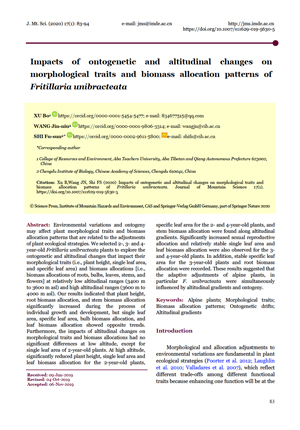NEWS 2020
Impacts of ontogenetic and altitudinal changes on morphological traits and biomass allocation patterns of Fritillaria unibracteata
XU Bo1, WANG Jin-niu2, SHI Fu-sun2
Journal of Mountain Science 17(1) 83-94 (2020)
https://doi.org/10.1007/s11629-019-5630-5
1College of Resources and Environment, Aba Teachers University, Aba Tibetan and Qiang Autonomous Prefecture 623002, China 2Chengdu Institute of Biology, Chinese Academy of Sciences, Chengdu 610041, China
Abstract
Environmental variations and ontogeny may affect plant morphological traits and biomass allocation patterns that are related to the adjustments of plant ecological strategies. We selected 2-, 3- and 4- year-old Fritillaria unibracteata plants to explore the ontogenetic and altitudinal changes that impact their morphological traits (i.e., plant height, single leaf area, and specific leaf area) and biomass allocations [i.e., biomass allocations of roots, bulbs, leaves, stems, and flowers] at relatively low altitudinal ranges (3400 m to 3600 m asl) and high altitudinal ranges (3600 m to 4000 m asl). Our results indicated that plant height, root biomass allocation, and stem biomass allocation significantly increased during the process of individual growth and development, but single leaf area, specific leaf area, bulb biomass allocation, and leaf biomass allocation showed opposite trends. Furthermore, the impacts of altitudinal changes on morphological traits and biomass allocations had no significant differences at low altitude, except for single leaf area of 2-year-old plants. At high altitude, significantly reduced plant height, single leaf area and leaf biomass allocation for the 2-year-old plants, specific leaf area for the 2- and 4-year-old plants, and stem biomass allocation were found along altitudinal gradients. Significantly increased sexual reproductive allocation and relatively stable single leaf area and leaf biomass allocation were also observed for the 3- and 4-year-old plants. In addition, stable specific leaf area for the 3-year-old plants and root biomass allocation were recorded. These results suggested that the adaptive adjustments of alpine plants, in particular F. unibracteata were simultaneously




